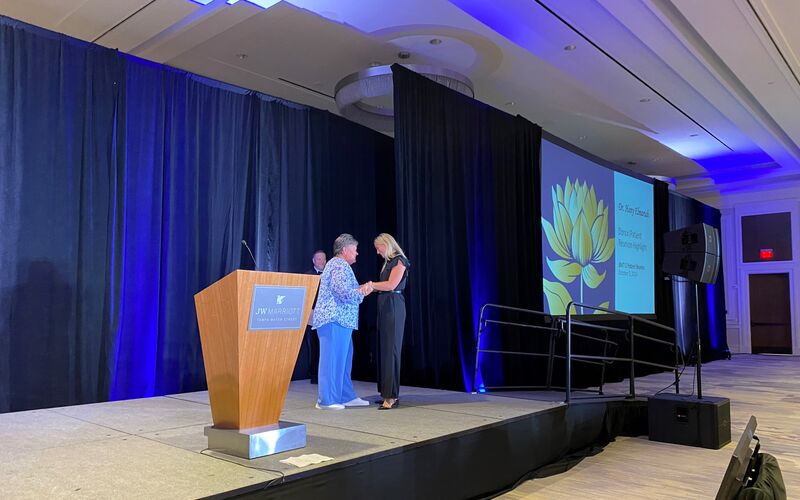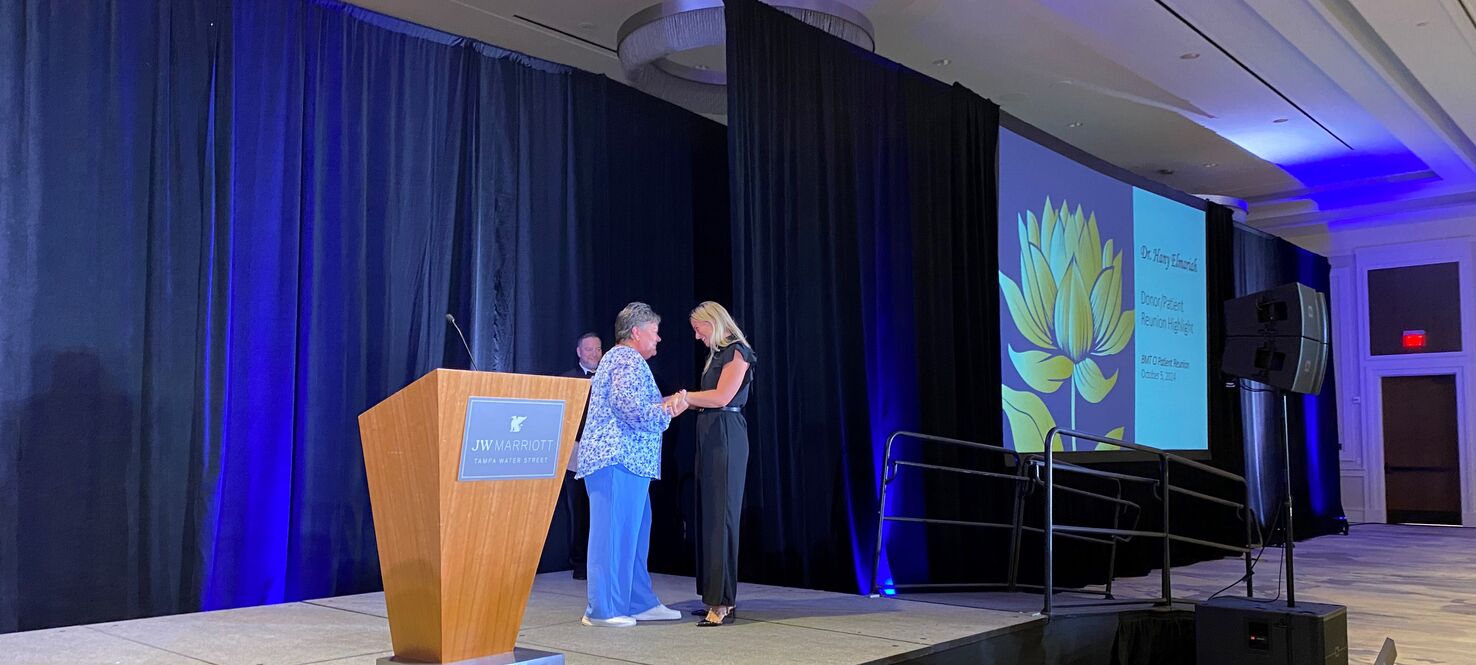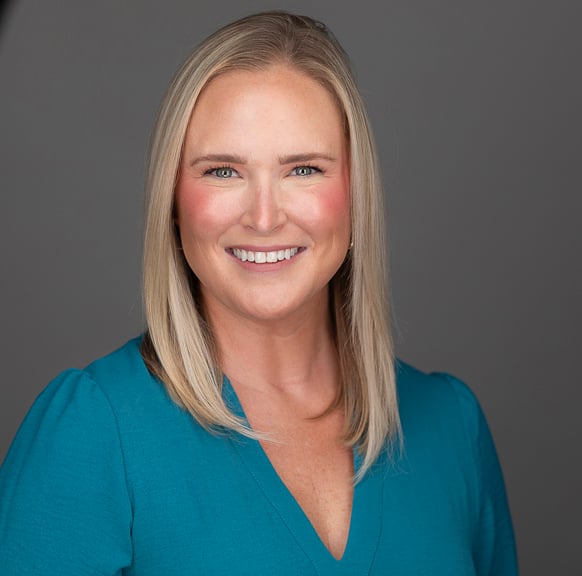An Unlikely Transplant Match Creates a LiveSaving Bond
Ashley McManus was a freshman at the University of Texas at Austin in 2016 when a seemingly ordinary walk to class became a life-altering decision. An organization on campus was raising money for cancer research and offered students a chance to sign up for the National Marrow Donor Program, known then as Be The Match.
Her friend was there asking students to sign up, so McManus gave her a sample and went on about her day, giving little thought to what she had just done. It wasn’t until years later she would realize how that friendly gesture would save a life and change her own forever.
“I am a yes person. And so, they asked me, and I had no problem getting my mouth swabbed on the way to class,” McManus said. “I mean, I never really thought I would get the phone call.”
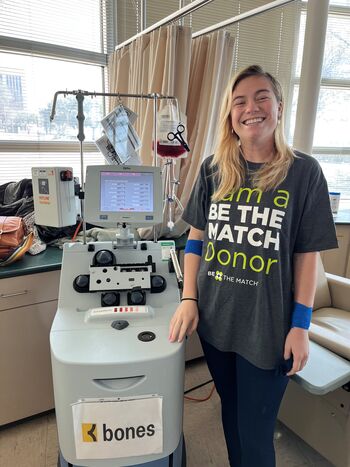
Ashley McManus never thought she would get a call she had a match when she submitted a sample to the National Marrow Donor Program.
Fast-forward five years, and nearly 1,000 miles away from Texas, 57-year-old Tracey Seiders went for blood work in Largo after struggling to walk and feeling symptoms of joint pain and fatigue. Her lab results indicated that her hemoglobin level was extremely low, and she was quickly admitted to the hospital.
Seiders, an ICU nurse who dedicated her life to helping others, received devastating news. She was diagnosed with acute myeloid leukemia. Her doctor suggested she seek treatment at Moffitt Cancer Center immediately.
“Needless to say, I was scared,” Seiders said. “When I arrived, it was midnight, and I met this wonderful charge nurse named Jessie. I told her I was stressed out because I didn’t know where I was or what was happening. So, she gave me a little tour and talked to me. She was instantaneously calming and reassuring, and we went through the whole admitting process.”
The following days were tough for Seiders. After receiving unwelcome news about her prognosis, she felt defeated. Medical staff informed her this was the worst type of leukemia with little chance of a cure, and she weighed the option of declining treatment and going home to hospice.
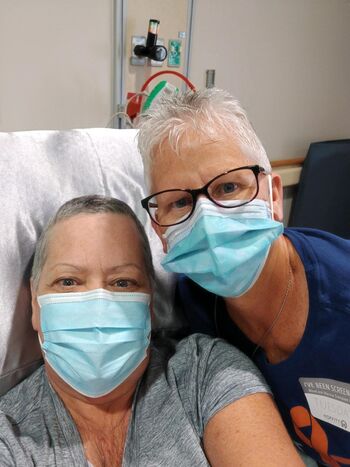
Tracey Seiders's wife Cathy was at her side during every appointment.
But with endless support from her wife Cathy and encouraging words from her family and physician, Seiders decided to face her disease head-on. Her treatment would include aggressive chemotherapy and a bone marrow transplant.
“Everything changed in my mind, and I was very focused. I had a target of where I would go, and nothing would stop me. So, I went through chemo. I started on Oct. 4, 2021, with my first round,” Seiders said.
After several rounds of chemotherapy, Seiders achieved remission in preparation for her transplant. But she faced another hurdle: Seiders had no family members who were a match. She enrolled in a clinical trial focused on improving transplant outcomes using mismatched, unrelated donors.
“After 30 days, I just said, ‘You know what, God, it is in your hands. I give it to you. I am done. I am not in control, you are. You take it, and let’s go,’” Seiders said.
Back in Texas, McManus was now 24 years old, newly married and starting her first corporate job in Houston. In December, her family received three phone calls from a number they initially thought was spam. When McManus called back, she learned she was a possible match for someone in need of a bone marrow transplant.
“It is funny now thinking about it. I am a person who hates going to the doctor. I hate shots. They make me cry,” McManus laughed. “When I told my mom I was doing this, she couldn’t believe it because I have been so scared of anything in the medical field.”
But without hesitation, McManus began the process to see if she could be a fit for the patient she only knew was a female in her fifties. After weeks of testing, she was approved and started prepping for her donation in February.
“They immediately approved me, and I started getting the shots,” McManus said. “I am a business major. It’s a cost-benefit analysis. What is your return on investment? A lot. Even though I did not like getting shots in my belly, you are doing it for a greater cause. It feels like the pain is minimal compared to your opportunity.”
Seiders had no idea preparation for a donor was happening until she got a call from Moffitt near the end of February. On Mar. 1, 2022, Tracey received her bone marrow transplant from McManus, her unrelated, partially matched hero.
“I was overwhelmed and elated that [the donation] was going to happen, and obviously relieved. I thought I was going to pass out,” Seiders said. “The only thing they would tell me then was that she was 24 years old. I could not believe a 24-year-old would do this for a stranger.”
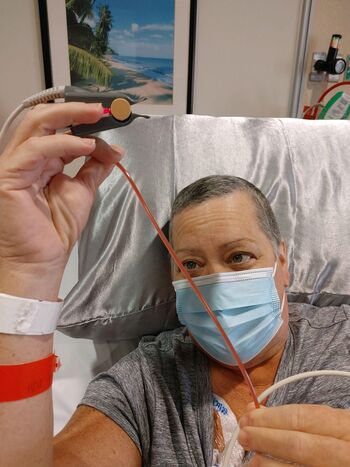
Seiders received her bone marrow transplant from her partially matched hero Mar. 1, 2022.
The transplant was successful. Seiders had very minor complications and made a full recovery. Over two years later, her leukemia remains in remission, her bone marrow is 100% donor cells, and she is back at work helping others overcome illness.
As months passed after the donation, McManus became curious about what happened to the recipient. Following protocol from the National Marrow Donor Program, she learned the patient was alive nine months later and received an anonymous letter from Seiders thanking her for her gift.
“I just wanted to hug her and thank her so much because it was really a gift,” Seiders said. “I mean, I don’t think thank you is enough. I don’t know how you show your appreciation for that.”
Earlier this year, McManus filled out paperwork to learn more about her anonymous recipient, but it became less of a priority as her family faced a wave of unimaginable events, losing nine family members in 13 months.
The day her grandfather passed away from cancer, she received a phone call from an unknown number. On the off chance, she picked up. The Moffitt Blood and Marrow Transplant and Cellular Immunotherapy Department was on the other end, inviting her to meet her recipient at the BMT Reunion in Tampa.
“It is such a God wink, right? We have no control over life and death in this world. But there’s also living life to the fullest, which is beautiful,” McManus said.

Seiders and McManus meet for the first time on stage at the BMT CI Patient Reunion.
On Saturday, Oct. 5, more than 700 people gathered at the JW Marriott Tampa to honor survivors and mark the program’s 35th anniversary. Providers shared insight into the program’s history, breakthroughs and new treatments.
Patients, caregivers and donors shared uplifting stories of life after transplant and immunotherapy, celebrating the shared journey of survivorship. McManus and Seiders were in the audience, but anticipation was building as the two still had not met. Seiders’ story was the last in the program to be shared.
“I was not prepared to speak, but apparently, I had to,” Seiders laughed. “So, at the end, I said, ‘Ashley, I know you are here somewhere. Can you just come up?’ She then came running up from the back, and she was so excited.”
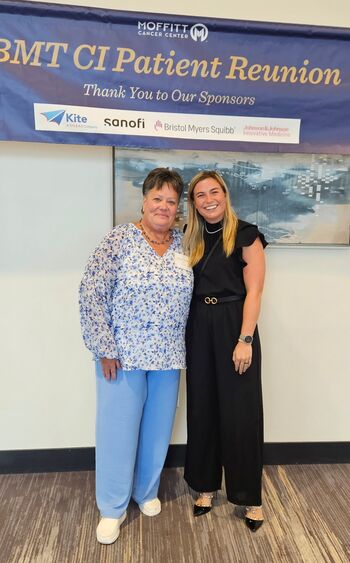
Seiders and McManus urge people to join the donor registry.
Overcome with emotion, they shared a heartfelt hug on stage for the first time in front of the crowd. “I felt myself at a loss for words because it’s overwhelming to look at someone who is looking at you like you saved my life,” McManus said. “It really was such a sweet experience.”
Over the next several hours, McManus, Seiders, and their spouses sat talking and getting to know each other. A lifelong friendship formed, and by the end of the evening, plans for future gatherings were already in the works.
“I’m so grateful that Moffitt allowed Tracy and I to meet each other because it’s truly such an honor to know her and see the life that she now gets to live,” said McManus.
A coincidental swab of McManus’s cheek and an imperfect match of cells offered Seiders a second chance at life. Now, the pair encourages others to consider joining the donor registry, as it could be someone’s best hope of survival.
“Just do it. It doesn’t hurt to get your cheek swabbed, and you never know who you’ll save,” Seiders said. “Ashley and I were a one-in-a-million chance to be matched. There needs to be more options for people.”


